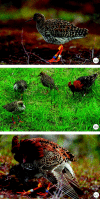Permanent female mimics in a lekking shorebird
- PMID: 17148353
- PMCID: PMC1618908
- DOI: 10.1098/rsbl.2005.0416
Permanent female mimics in a lekking shorebird
Abstract
Female mimics are known from many species, but permanent, non-conditional, alternative mating strategies are only known from an isopod, a fish, a lizard and a bird. The single bird example refers to lek-breeding ruffs Philomachus pugnax, a shorebird for which two strategies (independent and satellite) have been known for over 50 years. Ruffs also provided the single case of an animal with two, rather than three, permanent alternative mating strategies. Here, we describe a rare female-like morph of ruffs: the 'missing' third alternative mating strategy, which we have called 'faeder'. Faeders are slightly larger than females and in late April have testes 2.5 time the size of testes of normal males. On leks in aviaries and in the wild they appear to combine feminine and masculine behaviours. Faeders may represent the ancestral, care-giving, male strategy, but their relatively large testes suggest that currently they behave as sneakers.
Figures


References
-
- Andersson M. Princeton University Press; Princeton, NJ: 1994. Sexual selection.
-
- Bachman G, Widemo F. Relationships between body composition, body size and alternative reproductive tactics in a lekking sandpiper, the ruff (Philomachus pugnax) Funct. Ecol. 1999;13:411–416. doi:10.1046/j.1365-2435.1999.00323.x - DOI
-
- Baker A.J, Piersma T, Greenslade A.D. Molecular versus phenotypic sexing in red knots. Condor. 1999;101:887–893.
-
- Goncalves D, Matos R, Fagundes T, Oliveira R. Bourgeoois males of the peacock blenny Salaria oavo, discriminate female mimics from females? Ethology. 2005;111:559–572. doi:10.1111/j.1439-0310.2005.01069.x - DOI
-
- Gross M.R. Alternative reproductive strategies and tactics: diversity within sexes. Trends Ecol. Evol. 1996;11:92–98. doi:10.1016/0169-5347(96)81050-0 - DOI - PubMed
MeSH terms
LinkOut - more resources
Full Text Sources
Other Literature Sources
Miscellaneous

